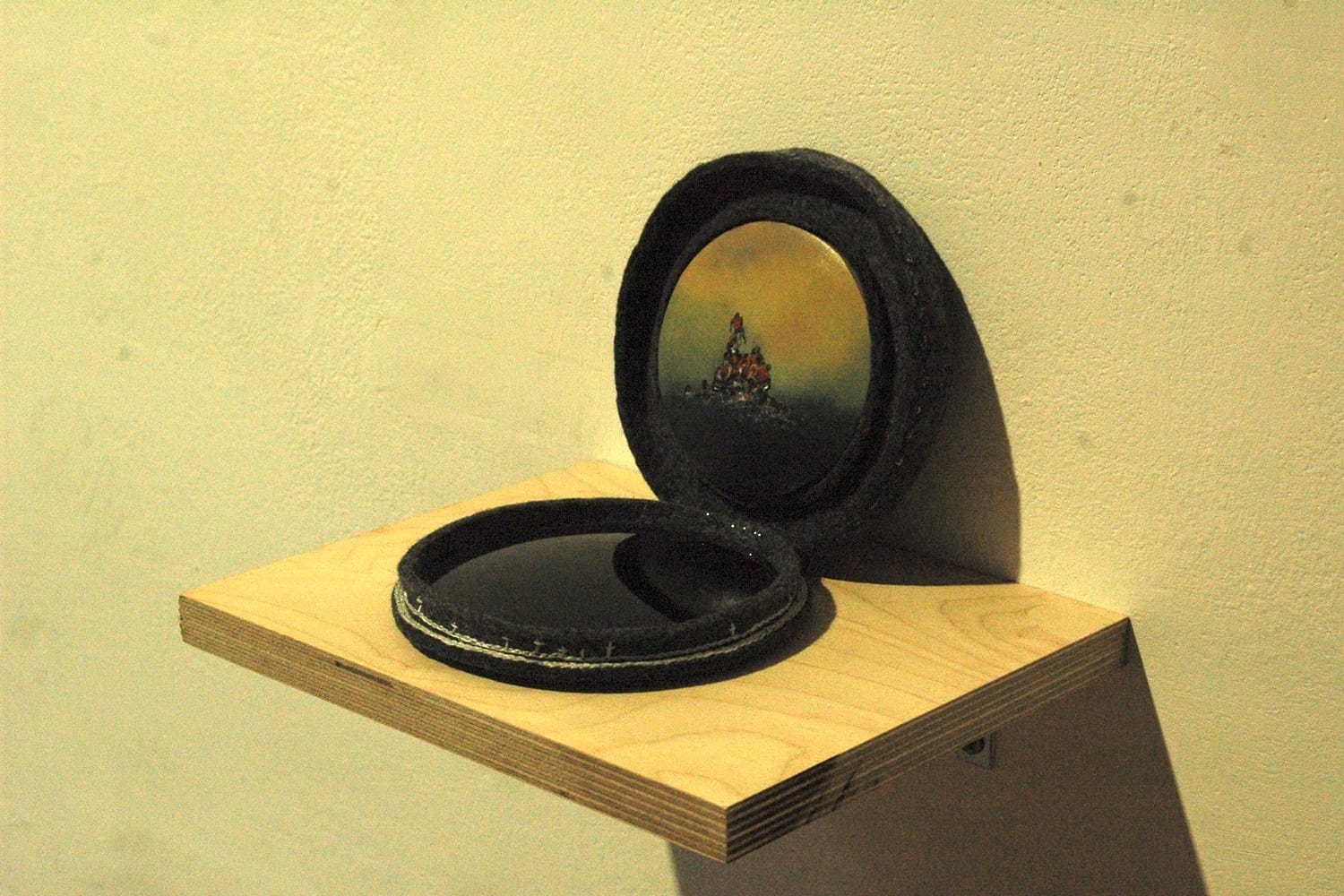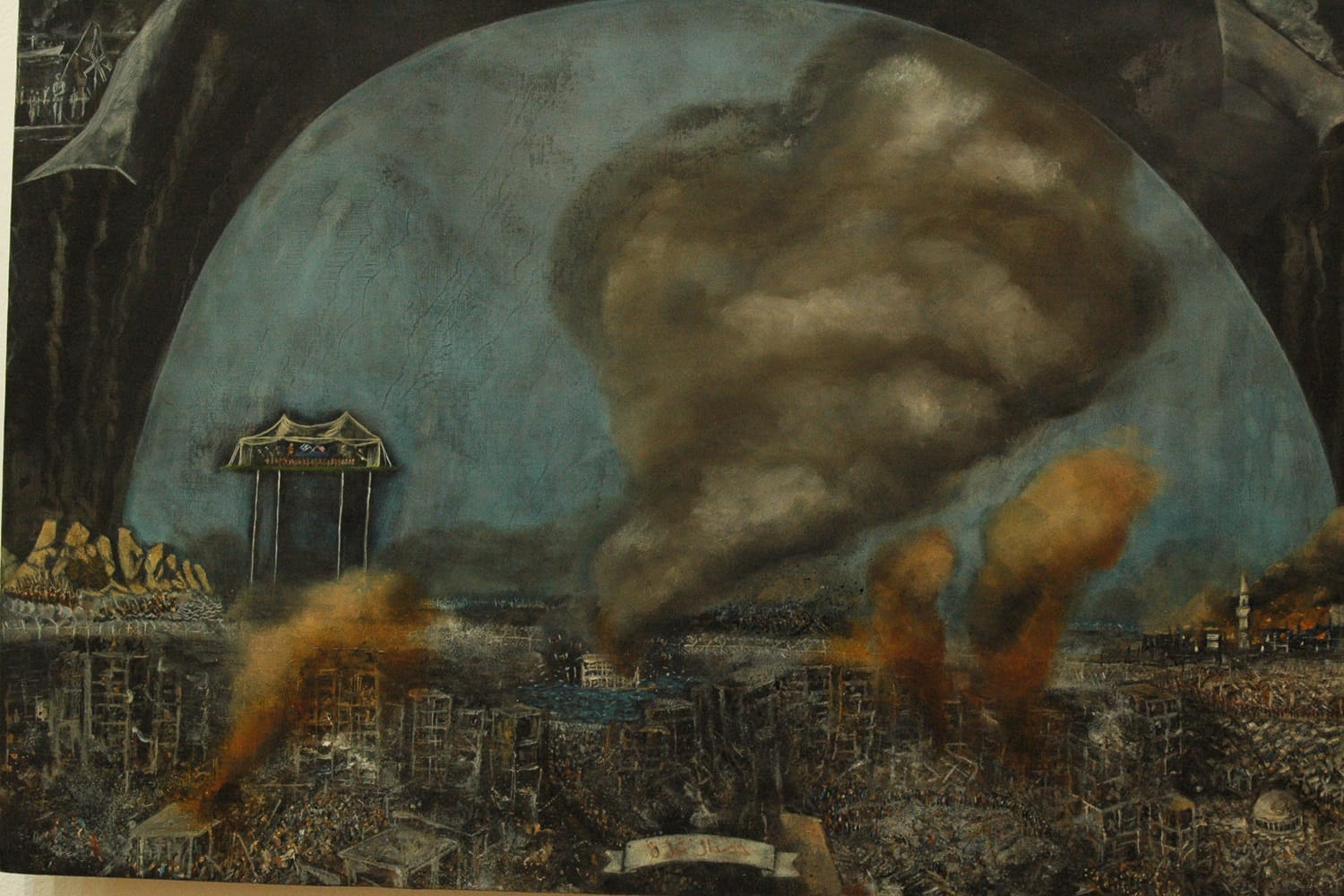What’s the best way to tell area residents about plans for a new asylum shelter nearby?
The government should tell communities directly about plans for new asylum shelters, some activists and politicians say.
In works like Claire Halpin and Rachel Fallon’s image of migrants adrift at sea, which echoes a 19th-century painting of French colonisers adrift at sea.

On Thursday evening, a small group of people huddled beside the closed front doors of Tøn, the art gallery in Temple Bar.
They were waiting to go inside. But the room was packed.
From the cobbled street, the only work clearly visible was a set of four black and white flags, variations on the United States of America’s Stars and Stripes.
Hanging above the crowd, the flags, titled “Signs of Distress” were hand-painted by artist Joy Gerrard, using ink on silk fabric.
Occasionally, someone would chance their arm, and squeeze inside, the front door hitting one or two misfortunate attendants on the other side.
Inside, they found a crowd filling the entire room, and lining the small staircase leading out to a drizzly Temple Lane South. Latecomers craned to hear a male voice that travelled from the opposite end of the gallery.
The voice belonged to the painter Paul Mac Cormaic, who was explaining one of two pieces he had featured in the show, titled “Daddy, there are some black people at the bottom of our garden”.
Mac Cormaic’s work juxtaposed the image of an Irish suburban back garden with a photograph of members of the West Side Boys, a Sierra Leonean militia.
He painted it 14 years ago, he said. “2010 was the beginning of the financial crash and the scapegoats, as always, were the immigrants.”
It was an exaggerated representation of anti-immigration rhetoric at the time, but that rhetoric now almost imitates this satire, he said. “Now, all the anti-immigrant people say ‘men of fighting age’, and so many people are believing this.”
Alongside Mac Cormaic, five other artists are also displaying pieces at Tøn as part of the exhibition To Never Look Away, reflecting on how war and conflict is perceived and portrayed in contemporary media.
The pieces, which include painting, sculpture, installations, and hand-crafts, are united by a surface-level of beauty, with an underlying political question, says painter Claire Halpin, who curated the show which runs until 31 March.
“You’re drawn in by the lure of the surface of the painting, the beauty of the material,” she says, “and faced with a more serious message.”
On Friday evening, the day after the opening, Halpin lifted a convex circle of glass out of a felted-wool box.
It’s known as a Claude glass, Halpin said as she inspected its surface. “It was used in the 17th century to look at landscapes.”
A painter would go to an ideal spot and view the landscape in its reflection, she says. “It dulls down tones, and makes the landscape look more painterly.”
She puts the glass back in the box and it reflects a painting fitted into the lid, a tondo – a circular work popularised in 15th-century Italy – depicting a raft of people, migrants, adrift at sea.
This scene, which Halpin created, echoes The Raft of Medusa, a painting by French Romantic Théodore Géricault.
It captured the hellish wreckage of the Méduse naval ship in 1816, she says. “There’s a circularity to it, because that was the ship of the coloniser, and my subject is the people from the countries they colonised.”
A collaboration between Halpin and artist Rachel Fallon, the box, also titled To Never Look Away, acts as the thematic centrepiece in the show, Halpin says. “It’s about the artist making things more beautiful for their work, even if they are dealing with very difficult things.”

Halpin decided to paint the contemporary scene of migrants on a raft in a more classic artistic style, while Fallon recreated an arcane artefact to illustrate the perpetual story of everyday people fighting to escape conflict, she says.
“It’s done in a particular way where there is a slight familiarity, but that it also looks like a historic painting.”
As Halpin moves around the room, she pulls up an image on her phone.
The photo is of an oil painting she made in 2019, titled Gaza, May 18. A darkened landscape covered in dozens of thin, wavy smokesteams rising from the ground, a single plume in the centre.
In the middle of it all, is a small white marquee with US and Israeli flags.
Halpin had created this in response to the then-US president Donald Trump’s decision to officially open the American embassy in Jerusalem in May 2018, she says.
The opening of the embassy came six months after Trump declared Jerusalem the capital of Israel. This was a move rejected by United Nations members as its position was that the status of the city would be determined through negotiations between Israel and Palestine.
“He sent over [his son-in-law] Jared Kushner and the ceremony was done in this kinda gazebo.”
As she recounted her original inspiration for the piece, Halpin walked over to one particular canvas. Previously this was Gaza, May 18. But now it is reworked and retitled Siege of Gaza.

Haplin had painted over most of the original work, covering the smoky skies with a light-blue dome, referencing Israel’s Iron Dome air defence system. In the foreground is an intricate image of Gaza in ruins. Hundreds of tiny figures amid rubble.
Around the edges of the scene are Biblical references, like David and Goliath, and the Israelites crossing the Red Sea.
Halpin approached Siege of Gaza, as well as her four other works in the show, with a view to creating something that felt both current and urgent, she says.
Beside Fallon and Halpin’s collaborative work, just inside the window is a large iron chain propped up on a ring of red bricks.
Created by Fallon, the installation is titled Maternal Chain of Office – Order of Our Blessed Lady of the Food Bank.
The chain consists of cast-iron discs, each one an oversized recreation of a historic token used as an exchange for bread during wartime, Fallon says. “There are medals for growing grain in China, in Germany, and ones for the women’s war effort in the UK.”
The chain looks regal, says Halpin, as she stands over Fallon’s work in the gallery. “But there’s a futility to it, because it looks like a chain of office that you couldn’t possibly wear.”
Fallon wanted to reflect on what a war actually is to the everyday citizen, she says. “It’s really about the juxtaposition of what war actually means in daily life, over and above the bombing and killing, it generally means famine, deprivation.”
Though she made the chain in 2018, it remains pertinent in the context of Gaza today, she says.
To Never Look Away is an attempt to grapple with the present by putting it side by side with the past, says the gallery’s co-director, Helen Kirk. “It captures the startling repetition of these events.”